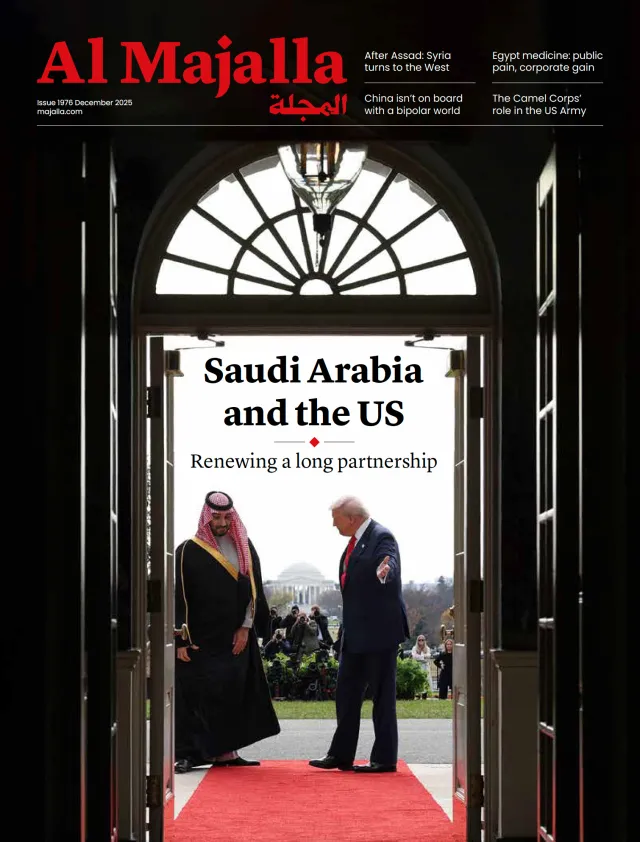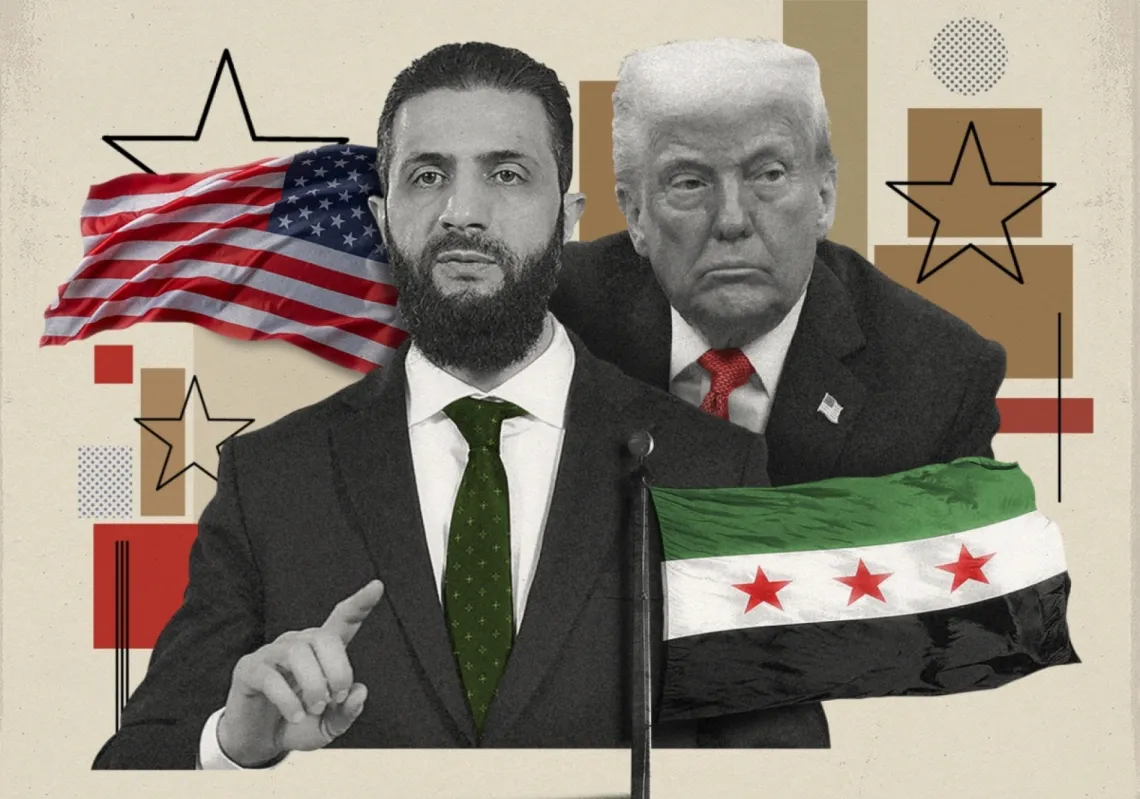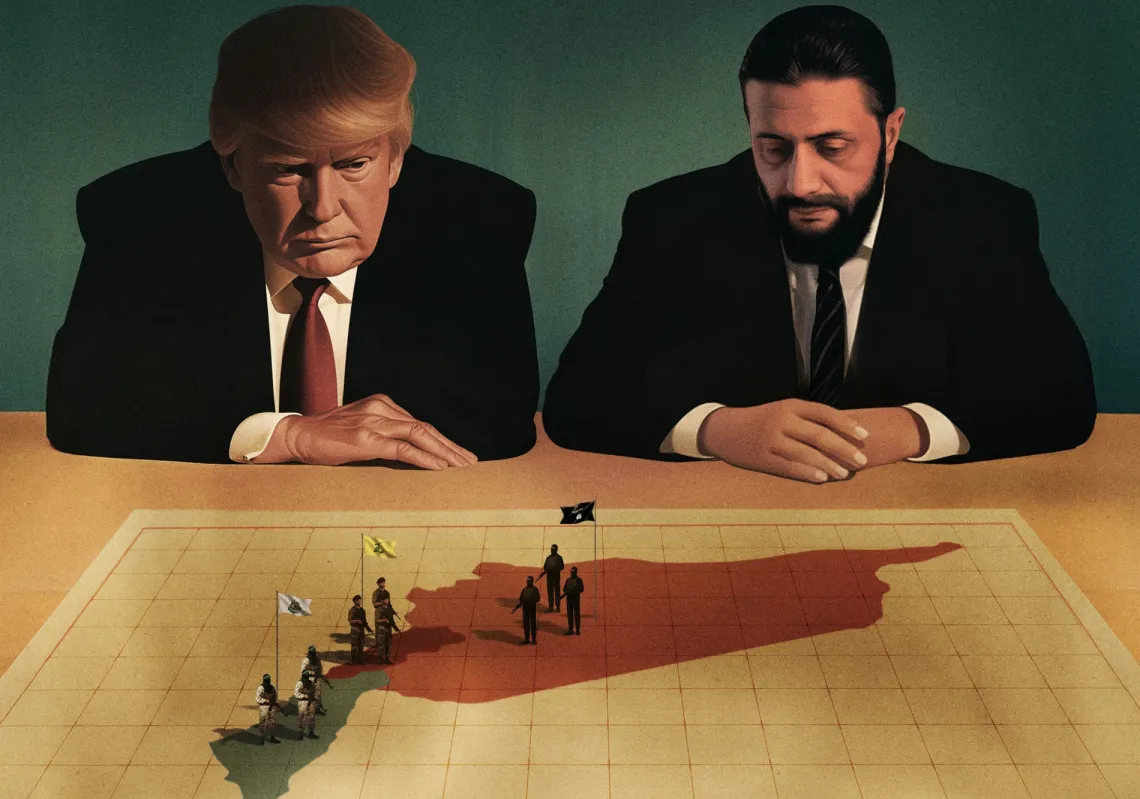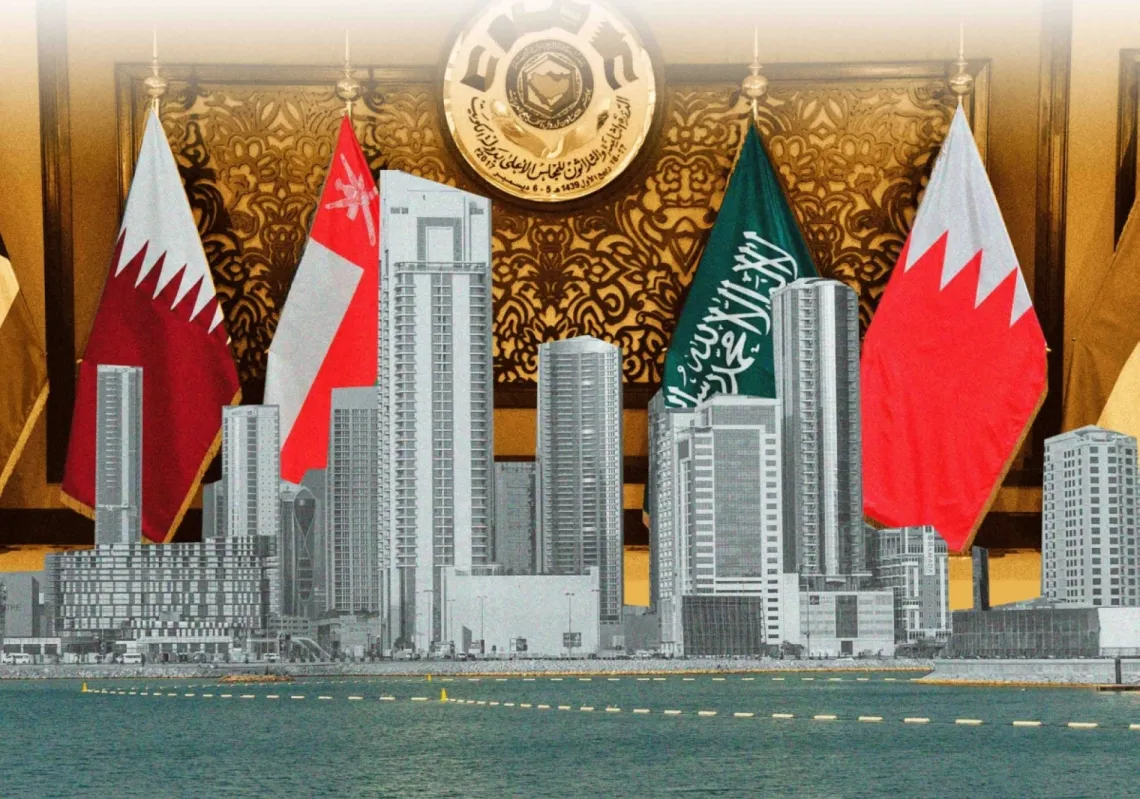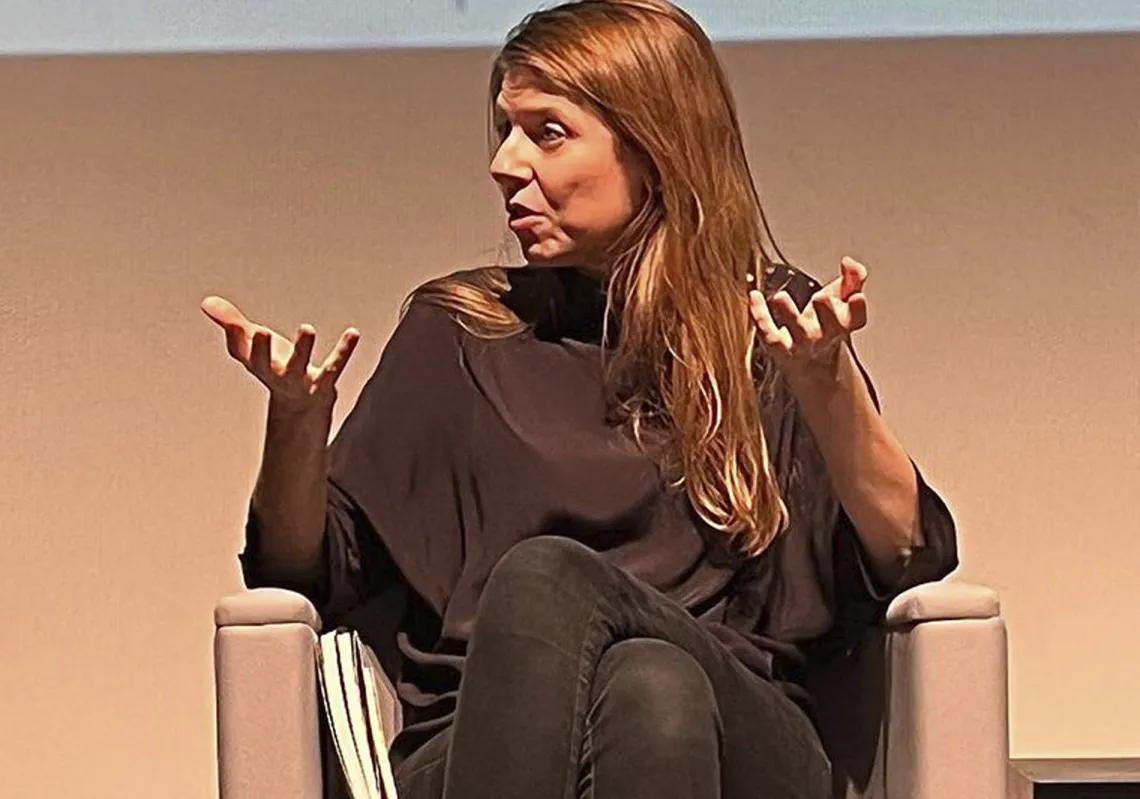On Tuesday, US President Donald Trump reversed nearly half a century of American policy towards Syria within a span of two to three hours. Somewhere between stepping off Air Force One, engaging in a long line of shaking hands with Saudi royal family members and dignitaries at the Royal Court, and stepping into the Riyadh Ritz Carlton’s for the Saudi-US Investment Forum, Trump was convinced to unwind layers of punitive sanctions imposed against Syria, a country emerging from the geopolitical and economic isolation of 14 years of civil war as well as 54 years of repressive Assad family rule.
When addressing the forum, Trump announced he was authorising the “cessation of sanctions in Syria in order to give them a chance at greatness.” The crowd—and soon streets, markets, and traffic circles in Syria—erupted in cheers and tears of joy. Finally, after six months of patience, a cautiously choreographed but complicated transitional process, advocacy, and hope, Syrians were given the chance they needed to rebuild.
Many expected that an eventual US decision to relieve Syria of its decades of sanctions would have stemmed from the collective efforts of civil society organisations, advocacy groups, Congressional representatives, and foreign governmental officials that have banded together since the fall of al-Assad to convince Washington to shift its posture towards Syria. However, it was clear from the moment that Trump made the announcement that this was a decision mired by personal politics and, in many ways, luck, breaking an impressive dam of resistance built out by some of his closest advisors.
The path of most resistance
While Syrians around the world celebrated and Trump headed over to a state dinner at At-Turaif, Trump’s Middle East team—both in Riyadh and in Washington—were left in a haze of confusion. Over the last half year, a handful of influential Trump advisors and cabinet members built out a campaign of non-engagement with the Syria file.
It was a policy stance mired in steep hesitation and caution, given the ties the new interim government’s leader and key officials shared with Hayat Tahrir al-Sham (HTS)—a designated terrorist organisation that has a history with Al-Nusra and Al-Qaeda.

Israel’s immediate opposition to the new interim government did not help either. Successive Israeli air strikes into Syria made it clear that Tel Aviv would prefer the US not engage with the new leadership in Damascus. Committing to a posture of non-engagement and continued pressure also fit well within the Trump administration’s playbook towards regional adversaries such as Iran, mimicking the “maximum pressure” campaign that many Trump advisors swore by.
The approach of non-engagement with Syria also reflected Trump’s personal transactionalism, continuing punitive financial measures against Syria’s economy as a way to extract concessions and test the new Syrian leadership’s patience.
While the State Department incrementally issued lists of expectations for the new Syrian government that broadly stressed plurality, respect for minorities, and moderated behaviour, key members of Trump’s government put up larger walls to prevent the Syria file from appearing on the resolute desk. Officials such as National Security Council senior director for counter-terrorism, Sebastian Gorka, National Security Advisor Mike Waltz, and Director of National Intelligence Tulsi Gabbard, who had personally met with President Bashar al-Assad in 2017, all reportedly sustained a strict non-engagement stance on the situation in Syria.
Gorka reflected this stance in a Breitbart interview: "The Assad regime was a brutal dictatorship. Nevertheless, what you have in Damascus now isn’t some kind of Jeffersonian Democrat,” citing HTS’ historical ties with Al-Nusra and Al-Qaeda and his prediction that al-Sharaa would impose sharia law. He continued, “So you have somebody who has won a battle to take out this secular Alawite leader and replace the dictatorship with what? We don’t know.”
Read more: Ahmed al-Sharaa: the Syrian president with much to prove
This hesitation bled beyond Pennsylvania Avenue to Capitol Hill. Some congressional representatives, such as Representative Joe Wilson, Senator Elizabeth Warren, Representative Cory Mills, and Representative Marlin Stutzman, formed a chorus to advocate for sanctions relief. Both Wilson and Warren authored a bipartisan letter addressed to Secretary of State Rubio that pressed the State Department for clarification about its sanctions relief timeline and to reevaluate outdated sanctions in a post-Assad Syria.

Mills and Stutzman sought to draw further attention to the Syria file by travelling to Syria to meet with new interim government members and religious officials, remarking that investment in Syria’s new chapter represented a precious “opportunity” for the US.
Yet these voices, while bipartisan, were still in the minority. When asked to support reengagement with Syria, many congressional representatives remained hesitant to make a move that could jeopardise their relationship with the Trump administration, particularly given that the White House had not adopted a concrete position on Syria outside of the personal views of hawkish advisors and cabinet members.
The result was paralysis on the Syria file. While the noise calling for sanctions relief mounted from the outside, the US government did not budge. The Syrian interim government was making diplomatic strides with its regional counterparts, European Union members, and other respected governments in the international community.
Foreign Minister Asaad al-Shaibani was even able to make it to the United Nations and raise the three-starred Syrian revolutionary flag in the front plaza of the United Nations Headquarters in New York City, but, ironically, was shut out from Washington, restricted by a G-3 visa for representatives from non-recognised governments and without an invitation to engage with US officials while on American soil.
The administration stated that while al-Shaibani and some team members were allowed to enter the US, it was strictly for UN engagements and did not signal a shift in US policy whatsoever. The dam that sceptical Trump administration advisors had constructed was working.

Enter Saudi Arabia and Türkiye
Without a doubt, Trump’s foreign policy has always been mercurial, often intentionally defying the ‘rules’ in order to play both friends and foes against one another and lay the groundwork for sought-out deals. But Trump’s decision to change the script on Syria sanctions was different. What was it, exactly, that induced such a drastic shift in US policy? Or, perhaps, who convinced Trump to switch tack within three hours? It’s clear that at least two forces were able to break through the ‘wall’ that Trump’s team had carefully constructed.
First, it was clear that Crown Prince Mohammad Bin Salman played an outsized role and Turkish President Recep Tayyip Erdogan, a supporting one. The Saudi Crown Prince was alongside Trump from the moment Air Force One touched down in Saudi Arabia’s capital up to the moment that Trump took to the podium at the Saudi-US Investment Forum to announce his administration’s new Syria shift.
Under Mohammed bin Salman, Saudi Arabia has been exploring ways to broaden its role in Syria’s post-regime reconstruction landscape as a way to squeeze out opportunities for Iran to revive its former influence that flourished with the Assad family. Just two weeks before Trump’s visit, Saudi Arabia and Qatar jointly announced they would forgive Damascus’ $15.5mn in debt to the World Bank.
While this was only one small drop in the bucket addressing Syria’s gargantuan needs for financial recovery, this was a way for both Riyadh and Doha to test the waters of US tolerance for regional engagement with Syria, paving the way for a more formal request to play guarantor roles in Syria’s post-war economic landscape that could only be possible through the US’ blessing and major sanctions relief.

Similarly, Türkiye also seeks a guarantor role in Syria, particularly in its post-war security sector. Ankara had played a key supportive role with the initial offensive that eventually—and unexpectedly—drove the Assad regime out of Damascus and has incrementally sought to increase its security footprint in the country. Türkiye has begun redeveloping and staging its forces at Syria’s Tiyas ‘T4’ air base, preparing to deploy air defence systems there and potentially the Menaugh air base in Aleppo, while posturing itself to inherit much of the counter-Islamic State (IS) campaign in Syria’s badia desert region.
Saudi Arabia's $600bn promise to invest in the US, along with the purchase of a $142bn American weapons package through a defence cooperation agreement, made it worth it for Trump to go against the grain of existing US policy and the advisors who have upheld non-engagement, initiating a 180-degree shift through sanctions relief.
For his part, Erdogan likely framed US engagement on the Syria file and economic recovery efforts as a pathway for stability, enabling the US to eventually withdraw its forces from northeast Syria and transfer that responsibility to local forces, like the Syrian and Turkish armies. For Trump, who had just reduced US defence posture in northeast Syria by half in April, this checked a major box as his administration seeks to reduce its military footprint across the Middle East.
The second tour de force, however, had more to do with an internal political scramble within the White House’s team leading Middle East policy. Up until the visit, special envoy Steve Witkoff’s bandwidth was largely taken up by negotiations between Russia and Ukraine, the Iranian nuclear file, and achieving a hostage deal—if not a permanent ceasefire agreement—between Israel and Hamas.

While Witkoff was reportedly more open to engagement in a post-Assad Syria, his voice was crowded out by Trump’s more cautious, hawkish advisors. That is, until there was a reshuffling inside the White House. When the hammer finally came down on a Trump national security official in response to the infamous ‘Signalgate’, it fell on Mike Waltz. Waltz, after all, was the one to accidentally add a journalist from The Atlantic to the Signal group chat sharing sensitive intelligence about a US strike on Houthi militants in Yemen. However, the move cut off a chunk of the White House’s ‘wall of resistance’ on Syria, allowing for individuals like Steve Witkoff to go through.
Hard work and luck
The story of Trump’s sanctions relief decision is a story of both a collective fight from Syrians and their partners to chip away at hesitation towards sanctions relief, as well as a story of luck and personal politics inside the Trump administration’s key Middle East advisors.
Without a doubt, Trump’s foreign policy has always been mercurial, often intentionally defying the ‘rules’ in order to play both friends and foes against one another and lay the groundwork for sought-out deals. And the new interim government, with the support of civil society organisations, activists, and even partnered governments, carefully built a compelling case to reverse punitive financial measures on their country.
However, his decision to reverse decades of US policy on Syria within just a few hours in Riyadh reflects the weight of influence that Middle Eastern leaders can have on Trump’s decision-making process, as well as how an internal staff reshuffle can reshape US foreign policy.

